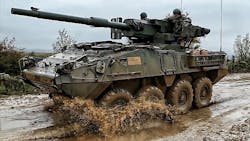General Dynamics to refurbish Army Stryker armored combat vehicles in deals worth $2.7 billion
Officials of the Army Contracting Command in Warren, Mich., are asking General Dynamics for retrofit, damage repair, and reset-refurbishment services to support the Stryker family of vehicles; as well as for Stryker wholesale supply, performance-based, logistics services.
A reset contract involves the repair and retrofit of battle-worn or damaged products to a like-new condition, which means to refurbish to near zero miles and hours of wear and tear.
The Stryker family of eight-wheeled armored fighting vehicles from General Dynamics Land Systems is a derivative of the Canadian LAV III combat vehicle from a General Dynamics-General Motors Defence Canada team, and is based on the Swiss Piranha III 8×8 combat vehicle.
Stryker is designed as a deployable fighting vehicle that is more lethal than light vehicles like Humvees, yet is lighter and more maneuverable than heavyweight combat vehicles like the M1 Abrams main battle tank.
Most Stryker vehicles today have the Protector M151 Remote Weapon Station with .50-cal M2 machine gun, 7.62 mm M240 machine gun, or Mk-19 automatic grenade launcher. Some heavily armed versions have a 105-millimeter main gun, similar to a tank.
Addition of 30-millimeter cannon turret to the Stryker would boost the vehicle's firepower substantially. A 30-millimeter cannon bullet is about 10 inches long, while a .50 caliber machine gun bullet is about five inches long, and a 7.62 millimeter machine gun bullet is about three inches long.
While .50 caliber and 7.62 millimeter machine guns primarily are anti-personnel rounds for fighting enemy soldiers, the 30-millimeter cannon is an anti-materiel or armor-piercing round that are effective against other armored vehicles and are capable of penetrating fortified bunkers.
Related: Army uses NGRAIN to assess battle damage on Stryker vehicles
The 30-millimeter cannon bullet comes in three varieties: armor-piercing, high-explosive, and training rounds. Armor-piercing and high-explosive cartridges typically have incendiary characteristics that can cause secondary fires on and inside targets.
The Stryker armored combat vehicle is named for two American servicemen who posthumously received the Medal of Honor: Private First Class Stuart S. Stryker, who died in World War II, and Specialist Four Robert F. Stryker, who died in the Vietnam War.
On these contracts General Dynamics will do the work at locations be determined with each order, and should be finished by February 2024. For more information contact General Dynamics Land Systems online at www.gdls.com, or the Army Contracting Command-Warren at www.tacom.army.mil.
Ready to make a purchase? Search the Military & Aerospace Electronics Buyer's Guide for companies, new products, press releases, and videos
